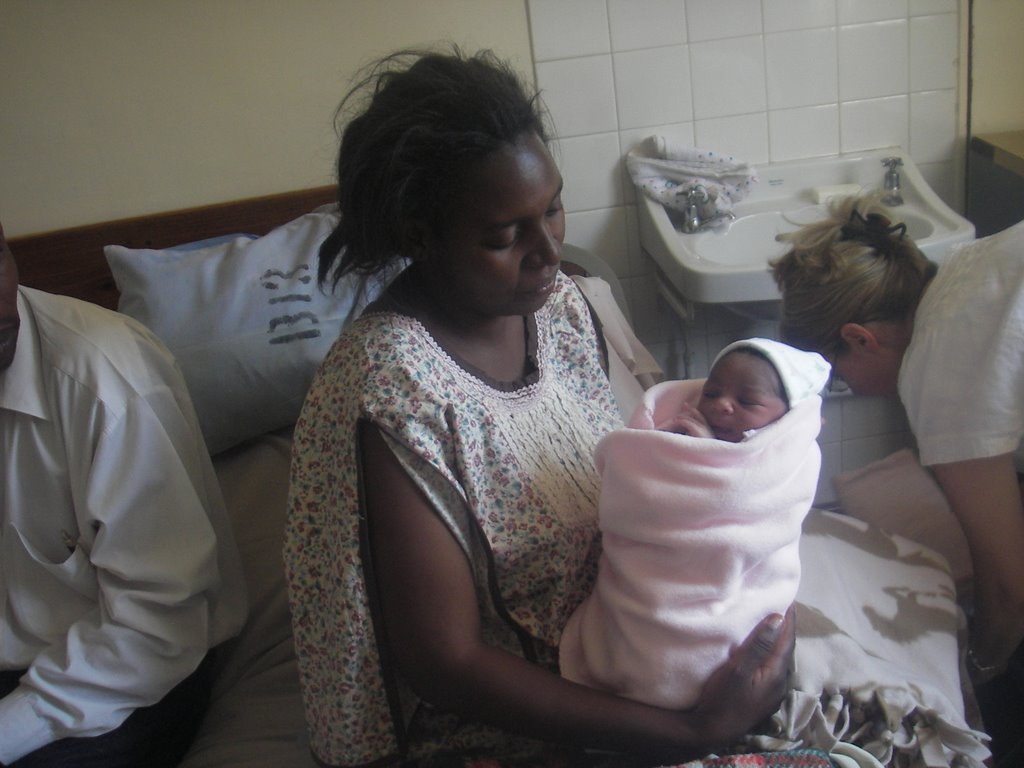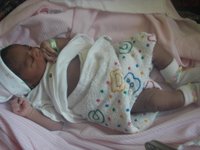 |
BIRTH STORIES BY MIDWIVES
Blessings in Zambia
First time mother is helped through labor
Tuesday, October 03, 2006
So
– on Sunday we headed off to church to the Lusaka branch. When
we arrived, I was told that Faith was in the hospital in labor,
but that we would go after the Sacrament. Indeed, after the passing
of the Sacrament was complete, Kathy, George (her husband) and I
headed to UTH. I had heard she was “high-risk”, so needed
to deliver in the hospital, but never did find out why she was classified
that way. Anyway, we got there, they confirmed she was there, but
there was some song-and-dance misunderstanding of why I was there.
Kathy paid for Faith to be in the “high-cost” ward. It
was $75. When that amount was paid, Faith was moved from the multi-bed
labor ward to a private room, where she was left completely alone.
Once they finally understood that I was a midwife who had come to
assist Faith in her birth (and lectured me in no uncertain terms
that I could not be walking back and forth in the hallway, that
once I went into her room, I could not come out again or they would
kick me out), then I was taken to her. She was in the hardest part
of her labor and we had never met, but I went to her and said “Hi,
Faith – I’m a friend of Kathy’s and I came to help”,
then started putting some counter-pressure on her hips and back.
Her relief was immediately evident. She was SO grateful, just to
have someone to help her with breathing just a little more slowly
and having someone touch her in labor. I always have a prayer in
my heart that the mothers I serve will feel my love through my hands
as I work with them and I know that Faith did. After just a few
contractions, a midwife came in to check her. She was going to give
her pain medication (because it was hard? Because she was now a
“high cost” patient? Who knows?) Anyway, she wanted to
check her first - she was 9 cm. I introduced myself as a midwife
and she talked to me about whether she should break her water or
not. I offered her a “Mem-cot,” a little thing that fits
over your gloved finger and has a tiny little hook like a little
thorn at the end. She enjoyed that (and my sterile gloves) so she
broke Faith’s water. I don’t think the midwife thought
it would go quite as fast as it did afterwards, as she didn’t
have everything she needed, but as soon as she broke her water,
we could see the top of the baby’s head. Within just a few
more contractions, the baby slipped out and went right up onto a
towel that was on Faith’s belly. (I found out later that Faith
even had to supply those towels to wipe the baby with.) She came
with a gush of blood, but the placenta delivered quickly and all
was well. They took the baby away – with blankets the family
provided – to be weighed and the wait until Faith was ready
to go to her postpartum room. I helped her get cleaned up, put on
a Depends, washed out the towel the baby was in (Faith was trying
to do it!), helped her to the bathroom (OK, the bedside commode),
changed her pad again, all before we ever saw the midwife again.
My holy heck. What would they do if Mom really had a problem? They’d
never even know . . . So – the midwife came back, did one blood
pressure, then we were off to the other side of that floor. We got
the baby on the way, then got them both settled in their private
room and I went and told Grandma Kathy and Daddy George that the
baby was here! I was only with her for ½ hour of her 12-hour
labor. I so would have liked to have been there for several hours,
but it did not work out that way. It did work out wonderfully, though.
Faith was absolutely delighted by the personal attention, I was
happy to have at least been at a birth in another country (something
I’ve wanted for years!), George was relieved there was someone
he kind of knew with his wife and Kathy was pleased as punch to
have gotten to be there and that the baby waited for her.

|
So – let me tell you some of what I have learned about birth around here. First of all, if you go to the hospital for any reason, you (or your family) is responsible for EVERYTHING - for bringing you food, for bathing you, for providing supplies for you and I mean everything – sheets, pillow, cotton or whatever you are using for pads, everything for the baby, just everything. So – for Faith, she brought all of her supplies and all of the baby’s supplies. Her aunt brought her tea and sandwiches at 6 in the morning, we gave her some granola bars after the birth and then she didn’t eat again until Kathy and Diane took her food that night. It’s just so different than what we expect. Faith had cockroaches in her room, a line of ants running along the floor, and later in the day, no running water. She was SO grateful that Kathy had paid for her to be in the “high cost” ward – she really was just so happy and so appreciative. I did see the “regular” ward – lots of beds pushed close together, and no privacy. Faith might have had too much privacy – no one checked on her at all, LOL. Of course, I was totally satisfied that both she and the baby were healthy and well before I left. Oh, I did get to weigh the baby and put an American cloth diaper on her. The diapers that Faith brought are really just old, big kitchen towels. I’m guessing they don’t have to worry AT ALL about hip clicks, because it was about the equivalent of quadruple-diapering! And did I mention the baby was absolutely darling? Wow. Cute, cute, cute. Her name is Blessings.
I’ve also learned some things both from TBA’s and just community birth attendants like: when you attend someone in labor, you come at the very end and just sit and wait until the head is being born. I have a small, isolated picture, I’m sure, but nowhere was it evident at the hospital that there is one iota of labor support and the local people I asked in the villages denied doing ANY kind of hands-on support. No wonder Faith thought I was so wonderful – she had never been touched in labor before! So – I always wonder how that happened – what happened to the traditional wisdom that you help moms physically during their labor? What about for back labor? Long labor? In the hospital, the midwife made Faith lie flat on her back in the “stranded beetle” position. When I asked the ladies in the village, they said semi-sitting or lying down. What happened to gravity-using positions and upright birth? Every culture has traditionally had standing, squatting and/or some sort of birth stool – what happened here that those are no longer used? Anyway, in the village when I taught on Wednesday, I showed the women how to use a chitenge to help turn a baby who is posterior (causing back labor) and how to do the “towel pull” with it that helps when pushing has gone on a long time. I taught them about kangaroo care, and how wearing those bitty premature babies can help save their lives and helps them grow faster and helps their brains develop better. I taught them about putting babies right on mom, and how that helps the baby get the normal germs for their environment right from mama, rather than being taken off somewhere (like I saw at the hospital). All of that was in simple terms, of course, but they knew and understood, I think, what I was trying to share. They were particularly excited about the chitenge uses. I’ll have to learn more about the “Rebozo way”, then simply apply it to the chitenge here. (A chitenge is a long piece of cloth that the women wear as a skirt. They also use it to tie their babies on their backs and many other things, but it’s basically just a long length of cloth.) I also got to do prenatals on 11 moms, 10 of whom got to hear their baby’s heartbeat for the first (and probably only) time. One was either not pregnant, or it was just too early. Two moms were due within the next two weeks. One mom was pregnant with twins – I got to hear two different heartbeats. Two moms had not yet felt the baby move, but we could heat the heartbeat with the Doppler. Both giggled and one said “So it is real?” I was able to assure her that yes, it was real. I saw one 14 yo mom-to-be, and a couple of Moms in their very early 20’s having their 3rd and 4th babies. I was surprised that fundal height ran SO much smaller than I am used to. I thought that was a universal measurement, but apparently not. The only mom who measured what I thought she ‘should’ was the one pregnant with twins and due in 8 weeks (meaning she was right on for just one baby). Maybe it’s the harsh village life and simply inadequate food. If I had to guess on baby’s size for the two due within 2 weeks, I’d say 5-pounders or so. Faith’s baby was 7-4, so nice and average by US standards.
I also learned some more about some of the common beliefs. As in Kenya, many people here believe that relations with a man are required to help “form” the baby throughout the pregnancy. But, many women here will stop at month six of pregnancy and not resume until 4+ months after the birth of the baby. I asked if the husbands “go elsewhere” and was told “of course”. If the women get into clinics and get prenatal care, then they are educated greatly about the normal course of pregnancy and have lots of questions answered, including that one, about what’s normal and to be expected. Most women do not have that luxury in Zambia. They also eat clay while they are pregnant. I knew it. Interestingly, they don’t seem to have much incidence of spina bifida or folic acid deficiency, so that must be one part of their diet adequately provided for. My goal when I get back to the States is to work with a few friends and develop about an 8-hour training to come back and do in the villages, as we hand out birthing kits. Oh, and I know another item we need to put in them – cloth pads for mama. I asked what they use for postpartum pads and Josephine told me most would use whatever old cloth they had that they did not plan on using again, so probably ratty and unwashed. No wonder infection is a problem - it's the number two killer here, following closely behind hemorrhage. So – we’ll add cloth mama pads (and elastic to hold them up) to the birth kits.
- Holly
